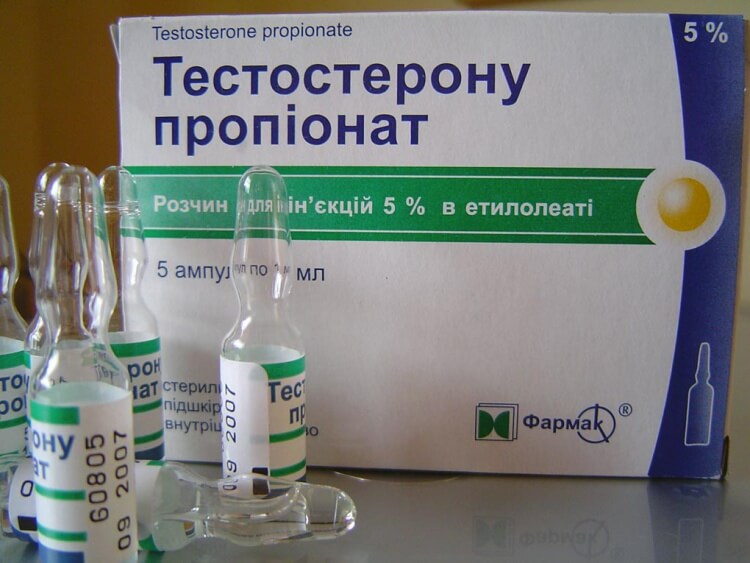
Testosterone is the primary male sex hormone. It is the responsible for producing mainly male-specific sexual traits. When synthesized, it is usually attached to an ester to delay its release into the body. Testosterone Propionate is the shortest commonly ester attached to the Testosterone hormone. This means it takes your body the least amount of time to rid itself of the ester and release the parent hormone into the body. Due to its short active life, testosterone propionate typically needs to be injected every other day at a minimum. Anecdotally, testosterone propionate causes the least side effects and the least bloating; these side effects usually subside very quickly when use is ceased.
Background
Testosterone was the first anabolic steroid developed, in the 1930’s. It has been used as the most potent mass builder for decades. Brand names of testosterone propionate include “Testovis” and “Virormone.”
Steroid Action
Testosterone is responsible for promoting health and well-being through enhanced libido, energy, immunity, increased fat loss, gaining and maintaining lean muscle mass, preventing Osteoporosis (loss of bone density) and possible protection against heart disease. Testosterone is also responsible for normal growth and development of male sex organs and maintenance of secondary sex characteristics. Secondary sex characteristics are specific traits that separate the two sexes, but are not directly part of the reproductive system, for example: chest and facial hair, a distinguished jaw line, broad shoulders and increased muscle mass. Testosterone binds to the Androgen Receptors (AR), which thus causes accelerated muscle gain, fat loss, and muscle repair and growth. These mechanisms are stimulated by activation of the Androgen Receptors (either directly or indirectly as DHT).
There are many possible side-effects associated with Testosterone Propionate use. This product has a high level of aromatization into estrogen and coverts to DHT (dihydrotestosterone) as well. Testosterone can convert to estrogen, the female sex hormone, creating a high risk of gynecomastia (formation of breast tissue in males). Also, supplementing Testosterone to your body will result in the shutting down of the body’s natural production of the hormone. The severity of side effects depend mostly on the dose and duration of circulating free testosterone and it’s conversion to estrogen and DHT. Testosterone’s anabolic/androgenic effects are dependant upon also dosage; the higher the dose the higher the muscle building effect. Testosterone typically promotes aggressive and dominant behavior.
Testosterone is the best mass builder known to man and recommended as the base of any mass building cycle.
Technical Data
Testosterone’s anabolic/androgenic effects are dependant upon the dose administered; usually the higher the dose, the better the results (1). In a study done on Testosterone (Enanthate in this case), a dose as high as 600 mg (per week) produced better results in subjects compared to those who received all of the lower doses. At the highest dose, 600 mg/week, the greatest results were achieved in comparison to any of the lower doses studied. The highest fat loss, most muscle growth, and increased size and strength were achieved at the higher dose (2). In the same study, HDL cholesterol was lowered and the subjects experienced acne. There was roughly a 15% gain in Lean Body Mass from 20 weeks of 600 mgs/week of Testosterone therapy.
Overall, the most common effect reported by subjects using testosterone was immense gains in strength (3). Alterations in size, shape, and appearance of the muscle were reported (4).
Due to stimulation of the Androgen Receptors (either directly or as DHT), accelerated muscle gain, fat loss, increased muscle repair and growth was experienced (5)(6). Testosterone binds to the AR on fat cells; therefore, adipose (fat) tissue can be broken down more readily while new fat formation is prevented (7). Since the body is building muscle at an accelerated rate, more ingested food is shuttled directly to the muscle tissue (this is known as nutrient portioning) and away from fat. This is another indirect effect of testosterone on fat loss. Testosterone also promotes glycogen synthesis, which is activated by insulin in response to high glucose levels (8). Glycogen provides fuel to the muscle; therefore endurance and strength increases were reported during severe muscle breakdown in intense training and workouts.
Testosterone Propionate also converts to both Estrogen (through Aromatization) and Dihydrotestosterone (through 5a-reduction). Most of the side effects people experience with testosterone use is actually from it’s conversion to these two substrates. Thus, hair loss, water retention, acne, and other side effects are possible with use of this drug. Conversion to these hormones is also responsible for some of testosterone’s ability to build muscle; therefore when many side effects are avoided with the use of ancillary compounds, some of the muscle building properties are also stunted.
Also noteworthy is that Testosterone Propionate administration typically causes the shutdown of natural testosterone production.
User Notes
Testosterone Propionate is actually my favorite form of injectable testosterone. Anecdotally, this is because in myself as well as other users, this short acting ester would seem to produce far less water retention and a quicker onset of gains. The only down side to this particular form of testosterone is that it must be injected frequently, with many users (myself included) preferring to inject it every day or every other day at a dose of around 100 mg.
One of the most interesting things I found with my personal research on Testosterone Propionate is that when I was using it at a 100 mgs Every-Other-Day, my testosterone levels were still at the high end of normal. This would seem to indicate that drug tested athletes could probably use this same dose and still pass a doping test.

References
- J Lab Clin Med. 1995 Mar;125(3):326-33.
- Am J Physiol Endocrinol Metab. 2001 Dec;281(6):E1172-81.
- J Lab Clin Med. 1995 Mar;125(3):326-33.
- Am J Physiol. 1998 Nov;275(5 Pt 1):E864-712
- J Clin Endocrinol Metab. 1997 Feb;82(2):407-13
- Am J Physiol Endocrinol Metab. 2002 Mar;282(3):E601-7.
- Curr Opin Clin Nutr Metab Care. 2004 May;7(3):271-7.
- Curr Pharm Biotechnol. 2004 Oct;5(5):459-70.
- J Clin Endocrinol Metab. 2004 Oct;89(10):5245-55.
About the author
Anthony Roberts is an expert in the field of performance and image enhancing drugs. He has authored books ranging from the pharmacology of anabolic steroids and growth hormone to their illicit use and trafficking. His writing can be found in magazines such as Muscle Evolution, Muscle & Fitness, Human Enhancement Drugs, Muscle Insider, and Muscular Development.
